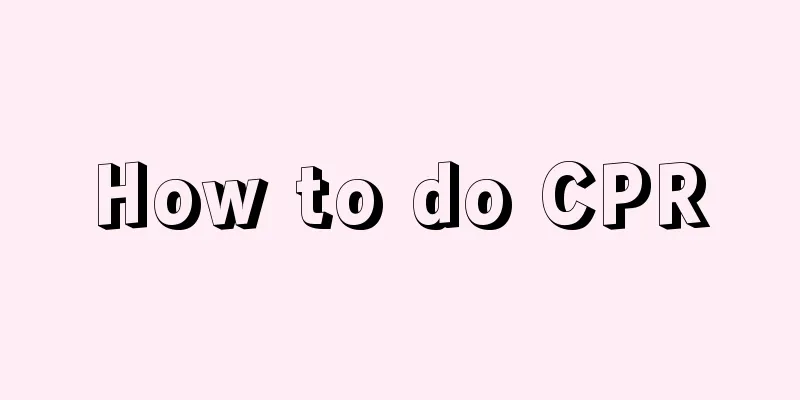How to do CPR

|
The heart is the most important organ in our human body. Once the heart stops beating, it means the end of life. However, in our daily life, there are always some sudden heart diseases that can cause the heart to stop beating, which will have a certain impact on the safety of life. If it is not rescued in time, life will be in danger. Therefore, it is necessary for us to master some common sense of life. Let’s learn about the practice of cardiopulmonary resuscitation below. CPR practice Step A Lay the patient flat on a flat surface. The first aider usually stands or kneels on the patient's right side, puts his left hand on the patient's forehead and presses back hard, puts his right fingers on the edge of the jaw, and lifts the head upward and forward. Notice Ask the patient to tilt his head back so that the axis of the patient's mouth and throat is in a straight line to prevent the tongue from blocking the airway opening and keep the airway open. Step B Mouth-to-mouth breathing, also known as artificial respiration. The rescuer presses down the jaw with his right hand to pry open the patient's mouth, pinches the nostrils with the thumb and index finger of his left hand, seals the outside of the patient's mouth with his lips, and uses moderate force to blow 800 ml of air 12 times per minute to perform the rescue. After one breath, the rescuer raises his head and takes a deep breath, while releasing his left hand. Continue with the previous step for the next insufflation until the patient has spontaneous breathing. Notice The insufflation should not be too strong or last too long to avoid acute gastric dilatation. At the same time, observe whether the patient's airway is unobstructed and whether the chest cavity is inflated. Step C External chest compressions. The rescuer is on the right side of the patient, with the base of his left palm placed on the lower part of the sternum on the patient's chest, and his right palm pressed on the back of his left hand. The fingers of both hands are raised without touching the patient's chest wall. He stretches his arms without bending his elbows, and presses down with his shoulders to create pressure, pushing the sternum down 4 to 5 cm (1 to 2 cm for children). Notice The pressure should not be too low to avoid damaging the liver, stomach and other internal organs. The pressure should be appropriate. Too light will not be enough to promote blood circulation; too heavy will cause sternum fracture and lead to pneumothorax and hemothorax. Step D Steps B and C should be performed simultaneously. After 30 compressions, perform two artificial respirations. Usually a rescue cycle consists of three rounds, that is, 90 compressions and 6 artificial respirations. After 30 minutes of rescue, if the patient's pupils shrink, he or she can breathe independently, his or her heartbeat recovers, and cyanosis disappears, the resuscitation can be considered successful. Conditions for terminating cardiopulmonary resuscitation: spontaneous breathing and pulse have been restored; medical personnel have arrived at the scene; after one hour of cardiopulmonary resuscitation, the victim's pupils are dilated and fixed, and the heart beats and breathing do not resume, indicating brain and cardiac death. Precautions 1. The amount of mouth-to-mouth air should not be too large, generally not exceeding 1200 ml, and a slight rise and fall of the chest is sufficient. The blowing time should not be too long, as it will cause acute gastric dilatation, bloating and vomiting. During the blowing process, pay attention to whether the patient's (injured person's) airway is unobstructed and whether the chest is inflated. 2. External cardiac massage can only be performed when the patient's (injured person's) heart has stopped beating. 3. Mouth-to-mouth ventilation and external chest compression should be performed simultaneously, and the ratio of ventilation and compression should be strictly followed. Too much or too little ventilation and compression will affect the success or failure of resuscitation. 4. The position of external chest compression must be accurate. Inaccuracy may easily damage other organs. The force of pressing should be appropriate. If the force is too great or too strong, it may easily cause sternal fracture and pneumothorax or hemothorax. If the force of pressing is too light, the chest pressure will be small and insufficient to promote blood circulation. 5. When performing cardiopulmonary resuscitation, the patient's (injured person's) buttons and belt should be loosened to avoid internal organ damage. The above is an introduction to the practice of cardiopulmonary resuscitation. After understanding it, we know that there are many methods of cardiopulmonary resuscitation, such as artificial respiration, etc. In addition, in order to avoid symptoms of heart arrest, we must have a regular schedule in our daily life. In addition, try to smoke and drink less in diet. If you have any heart discomfort, go to the hospital for treatment in time. |
<<: Is it good to eat pineapple when you have a cold?
>>: What to do if the foramen ovale of the heart is not closed
Recommend
How can high school students improve their memory
Do we all admire those who have super memory? Goo...
Is it okay to wash your hair during menstruation?
For most girls, menstruation should be a headache...
How long does it take to check EB for nasopharyngeal carcinoma
How long does it take to check EB for nasopharyng...
What diseases are easily confused with bladder cancer
The main symptom of bladder cancer is hematuria, ...
Is hyaluronic acid mask harmful?
There are many kinds of facial masks on the marke...
Will the eyes swell due to brain cancer?
Will brain cancer cause eyes to swell? 1. If a br...
Is it okay to apply lemon water on your face?
Lemons are for eating, but some people use lemons...
How to tie your hair into a shawl to look good
Different women have different requirements for t...
What is the cause of otitis media?
There are many causes of otitis media. In additio...
What is the cause of bloodshot eyes
Every day people either work in front of computer...
Analysis of the three major symptoms of advanced bladder cancer
Bladder cancer is a common disease in people'...
Is the smokeless moxibustion box effective?
Moxibustion is the main method of improving physi...
Is a heart rate of 66 normal?
Everyone's heartbeat is different, and the he...
Why are there more epithelial cells in urine routine tests?
During a routine urine test, if an increase in ep...
What causes anal itching in the middle of the night
As the main organ for defecation, the anus can ca...









